For years, the Pac-12 Conference was seen as a sleeping giant in college football and was the home to iconic programs and rich traditions, but often falling short in national relevance. Many blame this on playoff droughts and late-night kickoff times, but it was well known how much the conference struggled to keep pace with its other Power Five peers. Teams like USC, Oregon, UCLA, etc. left the conference in search of a new breath of fresh air. But now, after years of decline, reshuffling, and near collapse, Pac-2 football is showing signs of growth again trying to regain their PAC-12 status from before.
A New Foundation, A New Identity
After the 2024 season, the Pac-12 underwent massive realignment, with most of its marquee programs—USC, UCLA, Oregon, and Washington—departing for the Big Ten. At first glance, this looked like a death sentence for the conference as a whole. But instead of folding everything up, the conference chose to evolve and keep faith that they could grow the conference from the ground up again.
The new Pac-12, featuring schools like Oregon State, Washington State (which chose to stay with the conference after other schools left), and several additions from the Mountain West, is crafting a fresh identity. The new schools joining are Boise State, Colorado State, Fresno State, San Diego State, and Utah State. This also included Gonzaga, but they don’t have a football team, so the conference is looking for at least one more team to join before their self-proclaimed deadline of July 1st. Those other schools that are looking to possibly join are UNLV, Memphis, Tulane, UTSA, North Texas, and possibly Texas State. As of now, the conference is smaller, leaner, and more regional, but also more united in a clearer vision. Leadership is investing in football like never before, with schools upgrading facilities, hiring high-profile coaches, and focusing on competitive non-conference scheduling.
The Power of Parity
One of the most exciting developments in the new-look Pac-12 is its balance. Without the gravitational pull of bluebloods like USC and Oregon dominating year after year, the playing field has leveled. Programs like Fresno State, Boise State, and San Diego State bring rich football traditions and fan bases that are exciting/hungry for more school exposure.
The result is a conference where any team can realistically chase and compete for a title any given year This would create a more unpredictable and compelling product on the field. That parity is already beginning to draw more national attention and respect. This also is compelling to other group of 5 schools to join the growing conference to move themselves up the ranks into national exposure and a better chance at competing for a CFP berth.
Television and Streaming Opportunities
While media rights were part of the Pac-12’s previous downfall, the rebuilt conference is now exploring modern media strategies. The focus has shifted toward streaming platforms, digital partnerships, and flexible scheduling to avoid late-night obscurity. Streaming platforms can make more of their games easier accessible to watch for all the fans. This mixed with the better timing for games will naturally lead to more fan viewership.
More centralized kickoff times, strategic non-conference matchups to be competitive all year long, and creative branding could help the conference connect with more digitally native fans and tap into markets that were previously unreachable.
Embracing the Underdog Role
The Pac-12 has always carried a bit of a chip on its shoulder, but now it wears that underdog status with pride. Free from the distractions of blueblood politics, the conference can rebrand itself as a gritty, exciting, competitive league that rewards development and effort over hype. This can help the programs that do join the conference with recruiting more top players that are looking to play early while also being able to compete with the best of the best. The new NIL rules will help even out the playing field when it comes to being able to pay players but being apart of the new pronounced Power 5 and having more chance to play over joining some teams a part of the Big 2 (SEC and Big 10).
There’s something inherently appealing about a group of schools building success not through massive TV contracts or recruiting wars, but through a feel good story of persevering through turmoil on the way back up to regenerating football relevance. This style is not in the norm but it's authentic and that authenticity can resonate with fans and players tired of the big-money arms race dominating college football.
Looking Ahead
The new Pac-12 might not have the national spotlight yet, but it has momentum that can snowball in a good way with the proper next steps from the top leadership. With the expanded College Football Playoff format, there’s now a real path for teams outside the traditional power structures to compete for national titles. If the Pac-12 can send a team to the playoff, or even win a high-profile bowl, it could kickstart a broader renaissance that more teams would want to be a part of. The conference’s future will depend on media innovation, and maintaining the competitive balance that makes it so compelling. Being in the present with focusing on what they have going now while also keeping their eyes on the future and how to get better will be crucial for their development. But make no mistake about it, Pac-12 football isn’t dead. It’s just getting started!
